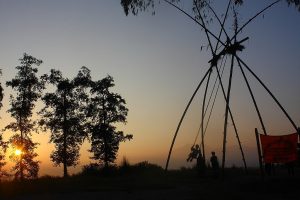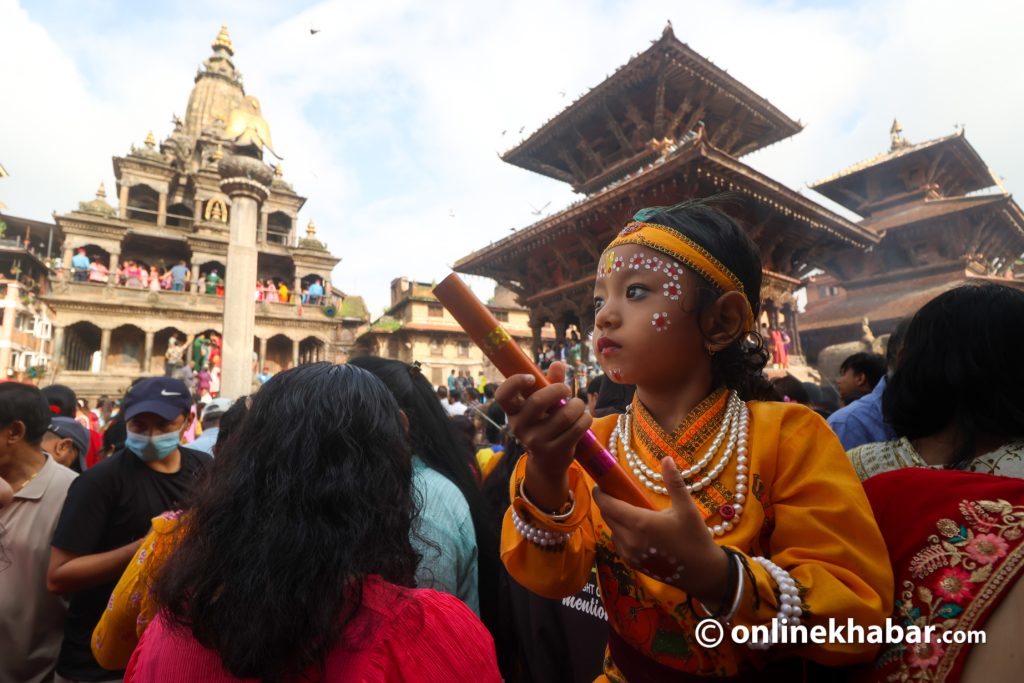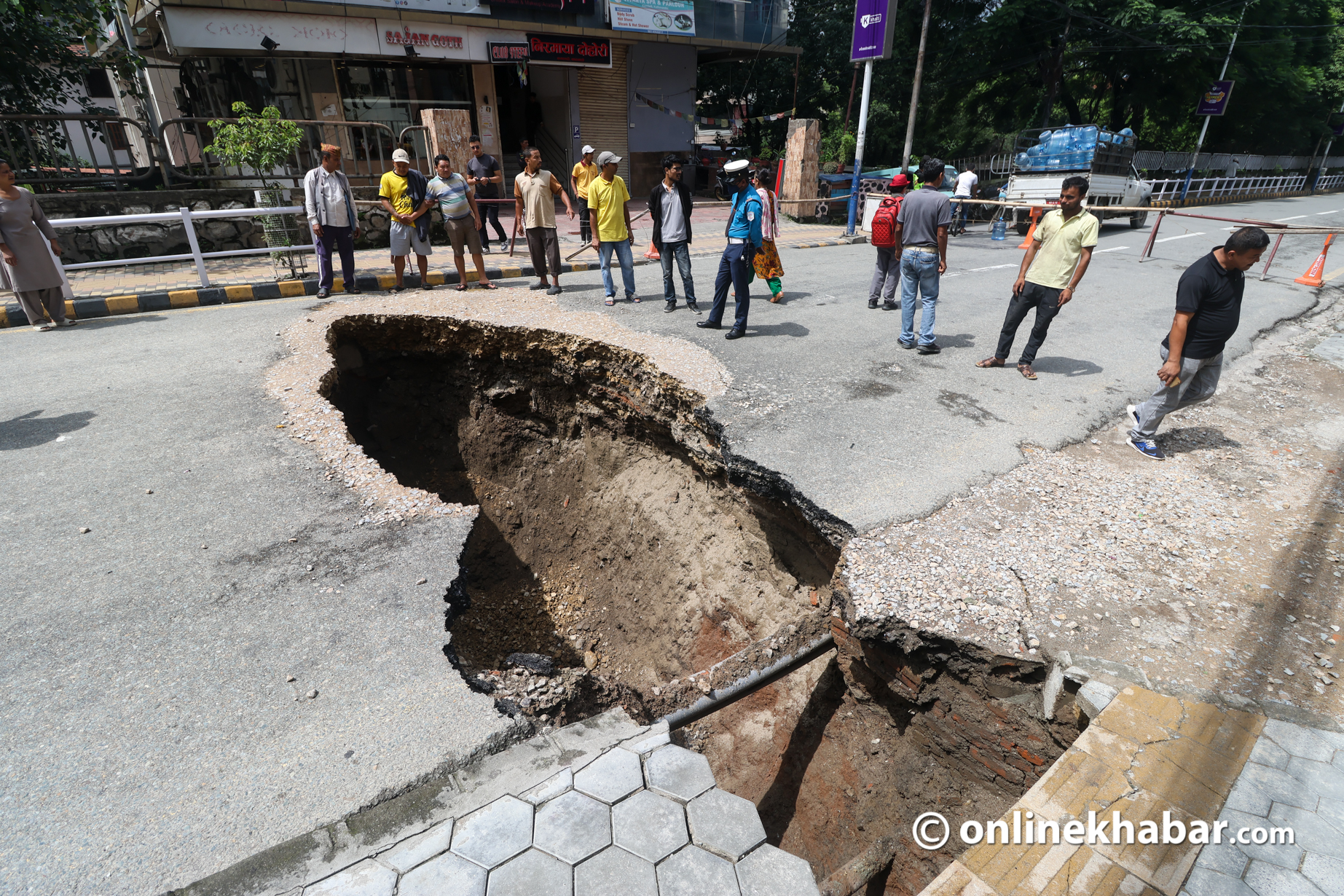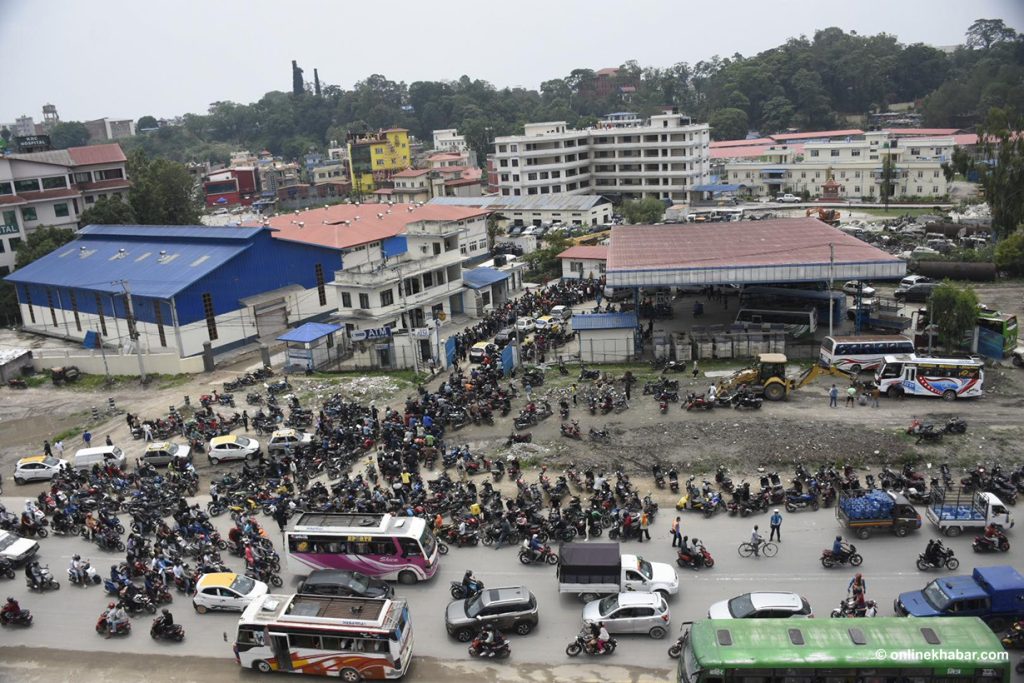
In the cold winter morning, the small nondescript square was basically an open space in a dense city. Cars with frosted windows and roofs stood in the centre. In a corner, two old Mercedes buses: rusty, parked for life. There was one Rana-era house, white façade, green windows. Next to it, a house half was torn down, presumably a casualty of the earthquake. Only the small temple, askew, propped up by beams, gave a touch of history, of age.
Tendrils of incense meandered up from the temple’s tiny courtyard. On the ground, without any attempt at concealment, were small piles of refuse: beer cans, cigarette stubs, cracker packages. It felt that the temple had been pushed to the metaphorical corner of life, neglected and near collapse. The present belonged, from what was visible, to concrete houses, cars, beer cans and Nepali Congress flags.
Just then a woman entered the courtyard and went into the poky sanctum. It was a Tuesday and she had come to perform puja at this Ganesh temple. She carried a small platter whose dimples contained rice, vermilion, lamp wicks and flowers. But simply in coming to this temple on the verge of collapse, she had brought much more. Her devotion was like a key that opened the doors to heritage. Within moments of her arrival, the tiny temple was a living monument.
I was in Patan, the ancient city. A channel had been opened that linked the past to the present, that woman to her grandmother.
Patan’s ancientness is certainly awesome, but the co-existence of the old and the modern is, at least for me, what makes it a special city. You can wander into an alley at random and find yourself in a courtyard with stone chaityas, intricately carved windows and, as if to remind visitors of the age they are in, motorbikes.
Enticed by the low door and narrow passageway of exposed bricks, I entered and found myself in a vihar, a Buddhist monastery. Patan is famous for them. It was a small square, enclosed on three sides by houses. The west wing housed the shrine. It had a wooden façade. A wooden toran, or tympanum, arched over the small door. A seated Buddha adorned it, with deities in a semi-circle around him. On each side of this sacred and artistic door were handwritten signs pasted on the tiled wall: one informed non-residents that they were not to park motorbikes in the courtyard; the other, right under a faucet with a green pipe attached to it, carried the water distribution schedule (7-8 AM; 6-7 PM).
Thirteen motorbikes filled the courtyard. In front of the characteristic Newar-style low doorways stood seven big, blue plastic drums, filled with precious water. On the east wall were four white oblong plaques with deities painted on them.
Across the street from the square was one of Patan’s most famous waterspouts: Aloka Hiti. In the winter morning I visited, it was quiet. A small group was chatting around a cardboard fire in a tin box. I remembered coming there for a festival during the monsoon. Back then, it had throbbed with a community preparing for a festival. Musicians played Newar instruments. There were mounds of rice. Sweetmeats were arranged to form a painting of sorts. Also on the table was a severed buffalo head. Now, there were people playing badminton in the corner.
Two 5000-litre plastic water tanks rose from the pit where the hitis, or stone spouts, were. There were a couple of diesel generators in a shed. The site of an age-old festival was now a place equipped to pump up and store underground water. In a way there was a beauty in the place’s duality: it was also where traditions were plumbed and stored.

People of Patan understand heritage better, hence they excel at preserving it. They know that the essence of heritage is intangible, malleable, flexible; it’s more realistic to keep it alive than keeping it unchanged. The soul of tradition is what needs to be saved, and it is that they have managed to keep alive. Outsiders are likely to feel a sense of loss or irony when they see motorbikes parked in a centuries-old monastery or a temple. Locals know the place is just being used. It’s utilisation without defilement. It’s dormant, not extinct. Come a certain month, week or day, the courtyard will be emptied of its motorbikes and be filled with offerings and hymns, the murmured prayers of the old and the joyful shrieks of the young.
Fortunately for outsiders, whose lives are not weaved into Patan’s legacy, there are also tangible links to the city’s past, expressed beautifully in architecture. The small gilded window on the Patan Darbar’s (Patan Museum’s) façade is one such architectural link. The central image on it is of the Buddha. He is surrounded by various Hindu deities, all of whom are rendered in smaller size than him. This is amazing given that the work was commissioned by a Hindu king. Portraying the Buddha as a centrifugal figure was probably the monarch’s way of acknowledging his predominantly Buddhist citizens.
Not that the two faiths were considered to be apart. Even centuries later religious synthesis is a hallmark of Patan. “Hindu gods need to be around to protect the Buddha,” Prakash Shakya, a Patan local, explained when I asked about the images of Hindu gods in the Golden Temple. The temple’s main door has the face of Bhairav etched on it as a protective measure and a diminutive statue of Balbhadra protects the main image of the Buddha in the inner sanctum by standing directly in front of it.
The Golden Temple is also the finest example of Patan’s collective memory. Nowhere is the handing down of culture from one generation to another more beautifully manifested. The head priest of Hiranya Varna Mahavihar, as the temple is called in Nepali, is a boy under 12. Each boy is priest for only a month. Local families take turns to send a son to be the custodian of one of Patan’s oldest and most revered temples.
According to legends, during a protracted battle between the Kirants and Lichhavis in Patan, it was too dangerous for adults to venture out of home. So the god at the Golden Temple couldn’t be worshipped. A family decided to send their son, a boy of eight or nine, to wash the god’s statue. The child arrived at the temple, drew water from the well behind the temple, and set the pot of water at the door. He thought god, like adults, would wash himself.
When even after repeated calls to come out and wash himself, the god did not appear. The boy began to cry, fearing he would be late and get a scolding at home. The god took pity on the boy and came out and performed his ablutions. The boy ran home and told his parents what had happened. When the locals learned of the story, they decided to have a pre-pubescent boy serve as the priest since it was clear that the god listened more to the pleas of little boys. That was how the practice of appointing a boy as the priest began. Every little detail of the daily rituals and duties that the boy-priest needs to perform has been passed down from one boy-priest to the next. Since there are no adult priests to teach them the duties and rules, the boy who is to succeed an incumbent starts coming to the temple daily fifteen days before his term starts to learn the ropes.

There is yet another, even more admirable, example of Patan’s uncanny ability to remember things from the distant past. The site of the present palace, which houses the Patan Museum, was once the location of a monastery. The significance of this hallowed site is not lost on the locals even centuries later. Every year in the sacred month of gunla, a large copper tub filled with water is placed in front of the main door. A small image of the Buddha is immersed in the water, a ritual recalling the monastery.
After witnessing locals engaged in rituals that have been performed for centuries, it becomes clear that Patan’s true heritage is preserved somewhere deeper and safer, in a form that can absorb changes and still retain its essence. Heritage has a home in the hearts and minds of the residents of Patan. As long as it resides there, it matters little how many motorbikes there are in an ancient courtyard.
Patan’s gems

Patan Museum
It’s something of an anomaly to recommend visiting a museum before wandering the alleys of a medieval city, but the Patan Museum’s rich collection prepares you for the city’s immense cultural artifacts. It has galleries dedicated to Hinduism and Buddhism, a gallery each on the lost wax and repousse techniques of metal casting and a poky room that houses a Tantric manuscript. Splendid objects are accompanied by succinct texts that introduce the religious, cultural and artistic heritage of the city in a way that allows even lay people to grasp it. Sundari Chok and Mul Chok, two of the palace’s medieval courtyards, are so well preserved that they seem to have been fossilised and then rediscovered. The newly opened architecture gallery exhibits special features of Newar architecture such as pillars, windows and torans.
Golden Temple
The ‘gold’ in its name comes, according to one source, from its gilded façade and roofs; according to another, it’s an allusion to the writing of a sacred text housed in the temple in golden ink every three years. In a historical and cultural sense, this temple is solid gold. It is one of the oldest, if not the oldest, monasteries in Patan. The monastery is a cultural and religious hub: daily recitations of mantras by locals begin at three-thirty in the morning. To get a glimpse of its ancient rituals, stop by at nine in the morning or three in the afternoon. At these times, the boy-priest sets out, ringing a bell, to retrace the path on which the god’s image was first carried into the temple.
Mahaboudha Temple
Tucked in a small courtyard, this shikhara-style temple is also known as the Nine-Thousand Buddha Temple—an allusion to the tiny Buddha figurines that are embossed on every single tile on the temple. The temple is in Sundhara Tole, which is southeast of Patan Darbar Square.
Kumbheshwor Temple
Hulking over the surrounding houses, this five-storied temple is a stellar example of Newar architecture. Its size is not its only appeal, with several intricately carved wooden beams testament to its artistic splendor. The temple is a magnet for the religious-minded. Within its precincts are some of the most revered shrines in the Kathmandu Valley. On the southern side is the Bhairav shrine, which houses a soot-black image of the fearful manifestation of Shiva. Adjacent to it is the Bagalamukhi shrine, which draws throngs every Thursday. The natural spring north of the temple is believed to be actually water flowing down from the holy Gosainkunda Lake.
Chyasal
An ordinary neighbourhood at first glance, Chyasal is a site of historical and cultural importance. According to legend, this was the place where the Kirants staged their last defence of their city against the invading Lichhavi forces. The slightly raised stone platform near the centre of the square, according to local legend, is a lid that covers a pit containing 800 human heads—the head count of the Kiranti warriors who died defending their city. There is no proof to corroborate this claim, but it cannot be entirely dismissed either because ‘chyasa’ in Newari means ‘eight hundred.’
Chyasal has a less macabre relic too. Ensconced on the wall, beside the stone water conduits in the square, is a statue of Gajalaxmi, believed to be the oldest stone sculpture in the Valley. There is also a three-headed idol of Ganesh in Chyasal. The locality is also famous for its annual sex show, a performance in which the shadows of actors engaged in seduction and love-making are projected onto a white screen, a giggle-fest attended by the entire community, elders and children alike.
Chyasal has four Bhairav shrines in the cardinal directions. Locals believe people residing in the area demarcated by these shrines are immune to acne. The most powerful of the shrines is the one in the south. On a special night in the year, when the god’s power is at its peak, sentries are posted on the alley leading to this shrine to prevent people from seeing the god’s image. Even the priest, who is tasked with covering the god’s face with a sheet of paper, does so with his back turned to it.
Bahals
Bahals are the religious and cultural nerve centres of Patan. These courtyards, adorned with chaityas and sculptures, are where daily life and old allegiances meet and merge. There are more than a dozen of these localities in Patan, not counting the small residential courtyards that abound in the city. Nag Bahal, which lies immediately behind (west) of the Golden Temple, is one of the biggest bahals of Patan. The large Buddha statue in it, with the palm turned southward, reflects the city’s mercantile past. Statues of the Buddha sitting in that posture always had their palms turned southward, a signpost for foreign traders, who would come with trains of porters carrying their goods. Patan’s bahals are bristling with architectural and cultural clues like these, a way to understand the past and invitations to interpret it in a different light. For this reason loitering in a bahal can turn into a scholarly investigation.
Vihars
Patan is one of the oldest Buddhist cities in the world. This aspect of its cultural heritage is evident in the numerous vihars, or monasteries, that are scattered throughout the city. The street going north from the Golden Temple has a couple of old vihars. If you are to visit only one of Patan’s old monasteries, it ought to be Rudra Varna Mahavihar, which is a mere five hundred metres from Darbar Square. It is one of the city’s oldest monasteries, built in the sixth century by the Lichhavi King, Shiva Deva. The monastery’s name, which translates as ‘red face,’ comes from the red-faced statue of Kwapadhya, or Shakyamuni Buddha, which is enshrined in the sanctum.























